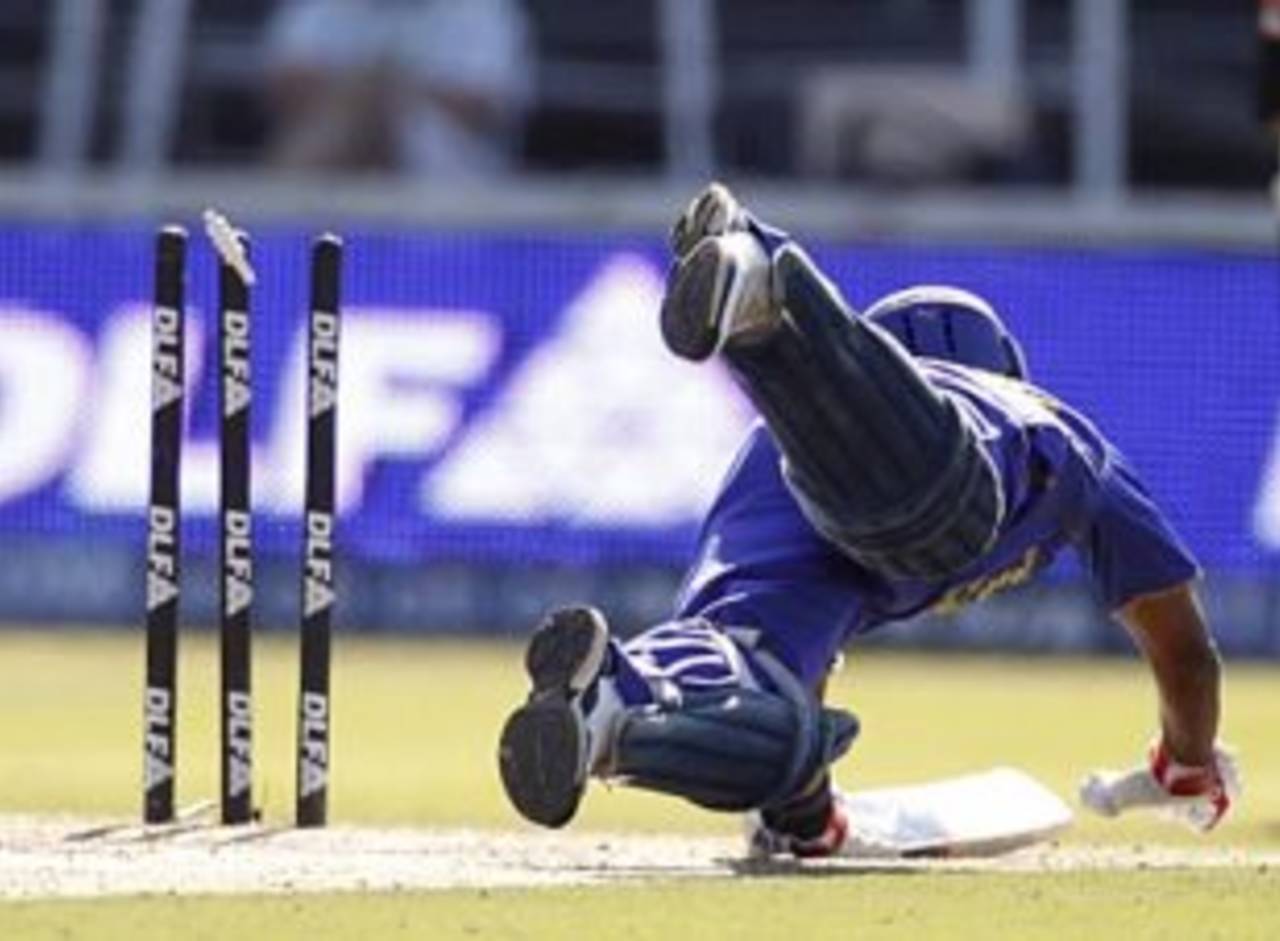I was initially going to write a poem for today. "Ode to the Run-Out". But after many failed attempts and finally falling asleep over a very poor first line - "Of all the ways of getting a batsman out/ there's nothing I like better than a run-out" - I'm sticking to the more prosaic but reliable blog format.
I came into this tournament pretty much as a lover of batsmen. All the cricketers I've ever loved (with the exception of Wasim Akram) have been batsmen, from Vivian Richards to Steve Waugh, all the way up to the young and delicious MS Dhoni. But five weeks into the IPL those emotions are swinging. I can feel myself being drawn more to the bowlers - their antics and tactics, their exuberant fist-pumping and aeroplane-flying and bull-charging. All of it.
Don't get me wrong, I still think there's something riveting about watching a batsman get into his zone. It's hypnotic. The thwack thwack thwack. There's plenty to admire about cover-drives and slogs and paddle-scoops, and there have been many memorable shows of batting bravado this season. But I think in this particular version of the game, and on these South African pitches, it's the bowlers who have been better able to showcase their talents.
Take
yesterday's matches: both crucial, both low-scoring. The highest batting score was 48 by Laxmi Shukla, but otherwise the performances were purely from the bowlers. It was mesmerising and a bit addictive - no sooner had one wicket fallen, than I was thinking, how is the next one going to go? Thirty-two fell in all.
I guess I also hadn't fully appreciated the many ways in which the bowler can outfox the batsman. I'm not talking about styles of delivery, because that's venturing into a jargon-filled land of spin and pace that's out of reach for me. I'm simply talking about ways. Like a catch. It's mind-boggling, the ways and ways to take a catch: the leap, the dive, the tumble, the fumbled, the clean, the confused, the shared, the dropped. This category by itself can bring endless hours of entertainment. Why don't they have a Man of the Catch award?
Then there's the stumping, which always sends a thrill of pure pleasure down your spine, even if the man walking back to the dugout is from your team. It's a clean, sharp dismissal, and when the stump flies into the air, the batsman can only glance back with an air of disbelief, in much the same way that a bowler will look to the boundary when a batsman has hit him for a six.
There's the lbw, which is too subtle for me. I can never tell if someone is out, unless I watch it on Hawk-Eye. If I were to watch a cricket match live without the aid of a commentator and replays, there's no way I'd be able to catch the lbw.
But my absolute favourite way of getting a batsman out has to be the run-out. I don't know what it is about the run-out, but to me it seems to epitomise the game of cricket perfectly. It involves communication on one hand and severe miscommunication on the other. There's, of course, the physical aspect of diving and scrambling, the nonchalant lope, the direct hit, the indirect run-out, but it's the moment of realisation, when the batsman is caught out of his territory - and he realises it, the bowler and fielders realise it, his partner on the other end realises it - this one giant moment of realisation, that you have taken a chance and you have to pay for it, is both heartbreaking and also pure adrenalin.
Yesterday we were treated to six run-outs. There were two in the Chennai Super Kings innings of George Bailey and Thilan Tushara, but the missed run-out of Jacob Oram was classic. I still don't understand why Oram was called back, but to see the replay of Ramesh Powar dive with all his graceful heft sideways was pure joy. The run-outs in the first match, though, were of a different quality. It started for the Rajasthan Royals with Swapnil Asnodkar's dismissal, followed by Yusuf Pathan and Tyron Henderson. Watching Pathan and Henderson go in similar fashion, with barely any breathing space between the two, was to watch Rajasthan's dream of another crack at the trophy disappear. And I guess that's the thing about run-outs: they're all so unnecessary, yet necessary.
Tishani Doshi is a writer and dancer based in Chennai

